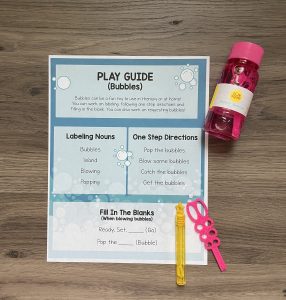
Pop, pop, pop! Bubbles can be a fun, naturally motivating, and engaging activity to utilize in therapy sessions. They can be used for children of all ages and at almost all language levels. Bubbles are particularly effective with students with Autism. Today, I am going to share 5 ways you can integrate bubbles into your therapy sessions!
Motivation
Bubbles are a no-prep activity most children enjoy! They can be used to motivate children who may be reluctant to walk back to a therapy room for a session or to simply establish rapport. They are also a great reward/incentive after completion of an activity. Many children with Autism or other communication disorders benefit from using a picture schedule. For children following a picture schedule, bubbles can easily be displayed on a picture icon and integrated into the schedule as a reward or a break!
Language Building
Bubbles easily engage children of all ages to address and target a variety of language objectives. At a basic level, you can practice requesting. This provides a natural opportunity for communication temptation so the child can request the desired item (bubbles) in his/her own way (i.e. visually , through pointing/reaching, or by vocalizing/verbalizing). Through blowing bubbles, you can also teach following directions (i.e. hold the wand, blow a bubble, pop the bubble). Sequencing skills may also be addressed, through guiding the child in following the steps of blowing a bubble and having him/her restate the steps involved. You can also work on spatial concepts, while directing the child to blow/pop bubbles in various areas (ie. under the table, on top of the table, beside the chair, etc.). In addition, bubbles provide opportunities to build receptive and expressive vocabulary through labeling a variety of nouns (i.e. wand, bubble), verbs (ie. blow, fall, float, pop), and adjectives/attributes (big, small, fast, slow). To further engage children, you can name the objects bubbles land on around the room/space you are working in (i.e. table, floor, etc.). This activity is also a wonderful way to work on increasing mean length of utterance (MLU) through expanding upon the child’s utterances (ie. If a child says “blow,” you could expand this utterance to “Blow bubbles;” “Blow the bubbles;” or “Blow more bubbles!”)
Articulation
Through bubble play, there are endless opportunities embedded to work on articulation, especially early developing speech sounds such as bilabials (/m/, /p/, /b/). The /m/ bilabial can be practiced through modeling and requesting “more” and “my turn.” The bilabial /p/ can be modeled in practiced through saying “pop!” The bilabial /b/ can be modeled and practiced through labeling “bubbles” or requesting “more bubbles.”
Social Skills
Social skills are an important foundation for building communication skills. Although all children need practice with social communication, those with Autism have increased difficulty with these skills. Bubbles offer an activity that’s naturally motivating to model and work on these skills. It’s a great way to work on joint attention through a shared activity. You can work on turn-taking skills by guiding the child to take turns blowing bubbles with you. This also provides an opportunity to work on reciprocal communication.
To help you integrate bubbles into your therapy sessions, ABA Speech is excited to offer a fun play guide! Be sure to scroll down and enter your e-mail address, to receive this play guide! This is the perfect supplement to ease your planning for activities and therapy sessions!

0 Comments